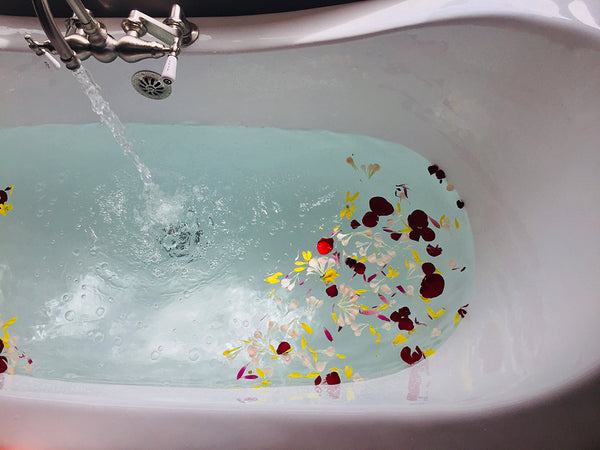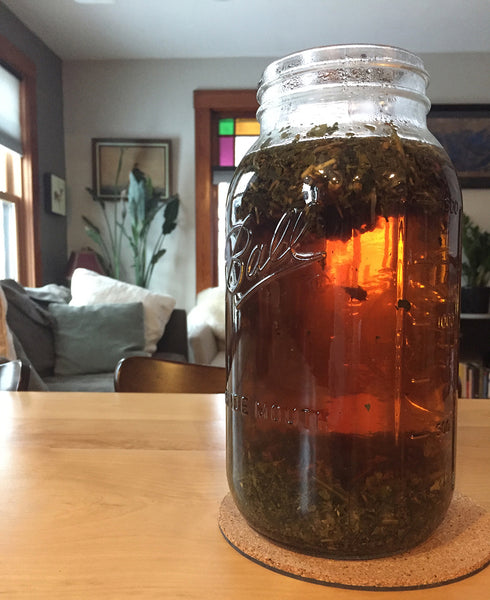Techniques and botanicals for a clear, healthy flow
Watch water flowing in the world: streams join into fast-flowing rivers, which empty out into seaside wetlands. Here, water rich in nutrients trickles between reed-covered islands. In our bodies, arterial rivers push water rich in nutrients into a branched system of drainage channels: the lymphatic system. Its origins are at the meeting point of blood and tissue, and it serves a vital role in keeping those tissues healthy and immune function strong. Our lymph flows everywhere--even in the brain--and a clear, strong flow yields wide-ranging benefits as a result.
The first key to flow is movement. Gentle exercise, massage, and techniques that physically squeeze and push the lymph go a long way towards maintaining healthy drainage. Herbs, applied topically as liniments and compresses, can revitalize the system, too.

But by turning to white blood cells that live in our lymphatic system (both at lymph nodes, where we find T and B lymphocytes, and at the tissue level, where we find macrophages), herbs can take things a step further. Botanicals such as red clover, cleavers, and horse chestnut contain compounds called coumarins (if you know the smell of fresh-cut hay drying in the sun, you know the smell of coumarins). Taken internally, coumarins help support the normal scavenging, clearing activity of the white blood cells living in our lymph. It doesn’t hurt that some, like cleavers, also work with the urinary system in traditional herbal medicine: the combination helps relieve temporary water weight gain.
This lymphatic action has other benefits, too: one of the most visible is to support skin health. Due to their ability to support clear flow and assist in the normal process of waste removal from tissues, many lymphatic herbs are traditionally taken as teas to support skin health . Remember that a little patience is required before noticing results.
Sometimes you need something more, and this is where plants that herbalists call “cooling pungents” shine. Botanicals like Echinacea contain compounds called alkyl-amides that give a gentle, cooling “tingle” when you taste them and speak to the immune system, too. As with the coumarins, they support the normal lymph-clearing activity of white blood cells--we think, at least in part, through the endocannabinoid system. Traditional herbalism called these plants “alteratives”.
At this time of year, when water swells and flows, we see a mirroring of these natural rhythms in our bodies, too. Herbs of spring (like cleavers, clovers, and fresh Echinacea buds) help support that flow--especially if combined with plenty of movement and some gentle self-care.
#1: Move your body!

Our lymphatic system lacks a central pump to keep the fluid moving, relying instead on muscular contraction to keep up the flow. Gentle movement is all that is required: a ten minute walk is perfect. Incorporate some slow, deep breathing during your walks: the biggest lymph channel in the body, known as the thoracic duct, relies on the bellows-like movement of the diaphragm.
Other options for gentle exercise include yoga, which encourages rhythmic stretching and contraction of the lower and upper body, coupled with deep breathing--an ideal combination.
After your walk or yoga session, consider “inversion” therapy: the practice of raising our feet above our heads gives the lymph a break from its constant struggle against gravity. You can find inversion tables that help set your body into this position. You can practice head/shoulder stand poses from yoga. But an easier way is called “legs up a wall” (a modified yoga pose). All you have to do is lie on your back, head away from the wall. Put your feet up on the wall, and then scoot as close as you can to the wall, trying to keep your legs as straight as possible, flexing at the hips. While this can be an intense stretch, all the lymph requires is inversion--so no need to push it. Relax there for 5-15 minutes--great after a walk or run.
#2: Dry brushing
This is a simple, gentle practice that is traditionally thought to support the natural movement of lymph and good circulation. Before showering, when your skin is still dry, take a natural-bristle brush (the kind you would use for body scrubbing in the shower) and use it to gently brush your skin. Using low to medium pressure, run the brush in long strokes up from your hands and feet to your arms and thighs, towards the heart. Use Added benefit: exfoliation!

#3: Warm compresses
Herbalists emphasize the connection between warmth and circulation. By brewing an herbal tea to apply directly to the body, we bring the benefits of warm water along and the power of plants, too--in a form that feels really nice. The simplest way to try this is to make a strong ginger tea and use it as a simple foot soak while it’s still warm. Another technique is to soak a clean cloth in the tea and apply it to specific areas of the body. Favorite places include the feet but also the neck, an area rich in lymphatic nodes that drain the head, eyes, ears and nose. Try 5 minutes of a warm compress in the evening before bed.
#4: Topical liniments and oils
Applying herbs topically is a time-honored tradition. The judicious use of tinctures or infused oils, in concentrated applications can be a great complement to the warm compress, or a good solution on-the-go. Coumarin-rich plants do well as liniments, as do botanicals with immune-supporting saponins like American poke (Phytolacca decandra). Poke root oil is traditionally used for lymphatic support. For more generalized applications, consider horse chestnut (Aesculus hippocastanum) as a tincture, oil, or cream. It is used for lymph support and is specific for vein health as well. You can use these applications a couple of times a day, but at least once, ideally after a warm bath or shower.

#5: Herbal teas
Plenty of water and fluids are needed for a healthy lymphatic system, and the extra fluid in a cup of herbal tea can help with overall hydration. So much the better if that tea is made from traditional lymphatic herbs, rich in coumarins and able to support good flow in this vital system. We favor certain members of the pea and bean family--notably, red clover (Trifolium pratense) and sweet clover (Melilotus officinalis) have a traditional use track record. The Galium genus, with members like cleavers (G. aparine) and sweet woodruff (G. odoratum), gives the lymph plenty of love, too. All these herbs are harvested in the spring, dried, and taken immediately as a tea or preserved to help support the lymph system all year round. Use 2-3g of any of these herbs (about 1 to 1 ½ teaspoons) in 8-12 oz of just-boiled water. Steep for 10 minutes, and drink at least 2-3 cups a day.
#6: A little extra kick
Alterative herbs (used to energetically “shift”, or alter, a situation) often have lymphatic power. This is a nod to the lymph’s central role in maintaining healthy balance in our body fluids and immune function. You can investigate botanicals like red root (Ceanothus species) or even American poke, but make sure to do so in partnership with your local herbalist. But a common garden plant might provide an easier inroad. Echinacea remains a favorite, accessible lymphatic alterative--and occasionally, people can find some fresh, especially in the spring. If you are one of these folks, consider harvesting tender leaves and small, button-sized unopened flower buds. Juice these, to add to your mix or smoothie blend, and consume about ½ tablespoon of juice twice a day. The gentle, refreshing tingle reminds you of Echinacea’s rich alterative chemistry. If young fresh tops are hard to find, a good tincture, made from the root of the plant, is a fine option. Take about 20-40 drops three times per day.
We may turn to the liver for detox support, to our immune system for resilience, to the heart and vessels for good circulation. But our lymphatic system plays an important role in all these body functions--and if you give it a little love, detox, immunity and circulation all may benefit. Plus, many techniques that support our lymphatic systems are great springtime rituals of renewal and reawakening. Start with a short walk and some deep breathing, finish with a warm cup of tea, and see where you end up.







